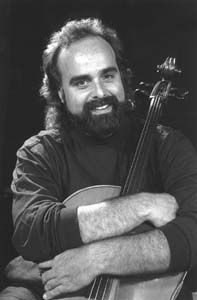![[MetroActive Music]](/music/gifs/music468.gif)
[ Music Index | Santa Cruz Week | MetroActive Central | Archives ]
Jazz and Giants
The county symphony opens the new millennium with a trio of imposing landmarks
By Scott MacClelland
IT MAY BE the oldest question of all: Which came first, The Creation of the World or William Trimble?
So far as anyone around here can remember, until Trimble showed up, no one had ever played Milhaud's groundbreaking jazz composition La Creation du Monde. Then, suddenly, everyone wanted to play it, and Trimble, the superb sax man, found creation giving him almost as much work as it gave God. John Larry Granger and the Santa Cruz County Symphony were the latest to embrace Milhaud's creative impulse of 1923 (following Ensemble Monterey, the Monterey County Symphony and New Music Works), and once again Trimble was the man who seemed to make it all possible. (Trimble was also a star in the San Jose Symphony's Bolero of last fall.)
Granger's reading in the afternoon of Jan. 9 was cleaner and more polished than any of the others. Though it lacked the grit and bite of jazz, it swayed with uptown smoothness and elegant sonority at Watsonville's Mello Center.
From the podium, Granger explained this program--decided a year earlier--as a "something old ... new ... borrowed ... blue" entry into the new millennium. While the Milhaud accounted for the blue, the borrowed would be Robert Hughes' new arrangement of two cello suites by Lou Harrison into one longer work of eight movements. Solo cellist Emil Miland was surrounded by 19 strings, who accounted for the piano and harp in the score for the original versions. (Harrison was in the audience and told me that Hughes had reordered the movements "wisely.")
Miland was an ideal choice for these dance-movements, making their long-spinning melodies sound deceptively easy. Granger's strings also remained keenly focused on keeping their delicate tissue clear and transparent. Sometimes, the movements rose up to climactic conclusions. At moments, Alan Hovhaness made his stylistic presence known. In the penultimate allegro, the solo was accompanied by the simplest of arpeggios, which created the most amazing effect.
Granger then led the old Symphony No. 5 by Beethoven in a warm and generous reading, which clearly took the measure of his musicians. His tempi were generally moderate and his dynamic contrasts were vivid but not exaggerated. Happily, the Mello acoustics became an enhancement to the performance. The violins struggled a bit with their first movement entrances (following the famous downbeat rest), suggesting the need for more leadership in rehearsals from the concertmaster.
The work unfolded at a natural-sounding pace, and the clarion brass figures in the finale were round-toned, full-bodied and secure. The only real trouble spot occurred at the end of the third movement when the bowed strings, pizzicato strings and chirping woodwind refused to come into focus with one another. But the finale, as Beethoven once wrote, seized fate by the throat, and came to a handsome conclusion with piccolos at the top and contrabassoonist Robert Hughes (el sabio) holding down the floor.
If the string corpus needs to brush up its disciplines a bit, the winds, like the brass, reiterated their formidable solo and choral presence. Likewise the percussion, who were secure, discrete and effective in their parts. The Mello audience was not as large as it has been earlier in the season, which must have the symphony people asking each other why. No doubt a bravura piano concerto would have made an obvious difference. But Beethoven's Fifth would seem to be a major attraction by itself. Then again, the most famous symphony in the world might actually be a little overexposed. As Yogi Berra is purported to have said, "No one goes there anymore; it's too crowded."
Copyright © Metro Publishing Inc. Maintained by Boulevards New Media.
![]()
 Strings of Life: Soloist Emil Miland's facile phrasing and the symphony's delicate touch made magnificent work of Lou Harrison's cello suites.
Strings of Life: Soloist Emil Miland's facile phrasing and the symphony's delicate touch made magnificent work of Lou Harrison's cello suites.
From the January 12-19, 2000 issue of Metro Santa Cruz.